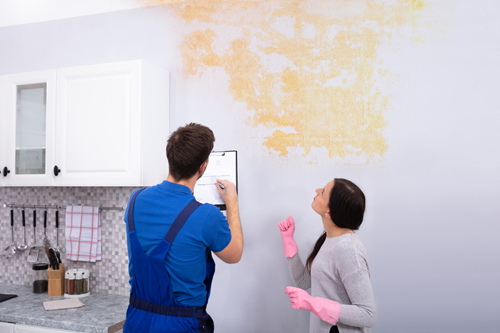6 Water Damage Reconstruction Do's as well as Don'ts.
6 Water Damage Reconstruction Do's as well as Don'ts.
Blog Article
What are your insights and beliefs on Ways to Reduce The Risk Of Fire And Water Damage?

Though water gives life, water invasion on parts where it's not supposed to be can lead to damages. If the water saturates right into your framework, it can peel off away surfaces and also wear down the structure. Mold and mold also prosper in a moist setting, which can be dangerous for your health and wellness. Houses with water damages smell old and also stuffy.
Water can come from numerous resources such as tropical cyclones, floods, burst pipelines, leakages, as well as sewer concerns. In case you experience water damages, it would be good to recognize some safety preventative measures. Right here are a few guidelines on exactly how to manage water damage.
Do Prioritize Home Insurance Policy Protection
Water damage from flood as a result of hefty winds is seasonal. Nonetheless, you can additionally experience an unexpected flood when a defective pipeline all of a sudden ruptures into your residence. It would be best to have residence insurance that covers both disasters such as all-natural catastrophes, as well as emergencies like broken plumbing.
Don't Fail To Remember to Shut Off Utilities
In case of a calamity, specifically if you stay in a flood-prone area, it would certainly be advisable to turn off the primary electric circuit. This removes power to your entire residence, avoiding electrical shocks when water is available in as it is a conductor. Additionally, don't neglect to turn off the main water line valve. When floodwaters are high, furniture will certainly walk around and also cause damages. Having the main valve shut off stops additional damages.
Do Stay Proactive as well as Heed Weather Condition Signals
Pay attention to discharge warnings if you live near a creek, river, or lake. Doing so lowers prospective residential or commercial property damage.
Do Not Neglect the Roofing System
Prior to the climate turns terrible, see to it you have a roof inspection. Actually, it would certainly be prudent to obtain this service every year as it can mitigate intricate concerns. You can stay clear of rainfall damage if there are no openings and leakages in your roofing system. Your roofing professional will additionally care for malfunctioning seamless gutters or any other indicators of weakening. This will protect against water from flowing down your wall surfaces and soaking your ceiling.
Do Focus On Tiny Leaks
A burst pipe does not occur overnight. You may notice gurgling paint, peeling wallpaper, water touches, water spots, or trickling noises behind the wall surfaces. Have your plumbing fixed before it results in substantial damage.
Do Not Panic in Case of a Burst Pipeline
Keeping your clearheadedness is essential in a time of dilemma. Since it will certainly suppress you from acting fast, stressing will just worsen the trouble. When it involves water damages, timing is key. The longer you wait, the even more damages you can anticipate. Hence, if a pipe bursts in your house, right away shut off your primary water valve to remove the source. Then disconnect all electrical outlets in the location or shut off the breaker for that part of the house. Call a credible water damage repair specialist for assistance.
Water provides life, water intrusion on components where it's not supposed to be can result in damages. Residences with water damage smell stuffy and old.
Water damage from flooding charges to hefty winds is seasonal. You may notice bubbling paint, peeling wallpaper, water touches, water discolorations, or trickling noises behind the walls. When it comes to water damages, timing is crucial.
Some Do's & Don't When Dealing with a Water Damage
DO:
Make sure the water source has been eliminated. Contact a plumber if needed. Turn off circuit breakers supplying electricity to wet areas and unplug any electronics that are on wet carpet or surfaces Remove small furniture items Remove as much excess water as possible by mopping or blotting; Use WHITE towels to blot wet carpeting Wipe water from wooden furniture after removing anything on it Remove and prop up wet upholstery cushions for even drying (check for any bleeding) Pin up curtains or furniture skirts if needed Place aluminum foil, saucers or wood blocks between furniture legs and wet carpet Turn on air conditioning for maximum drying in winter and open windows in the summer Open any drawers and cabinets affected for complete drying but do not force them open Remove any valuable art objects or paintings to a safe, dry place Open any suitcases or luggage that may have been affected to dry, preferably in sunlight Hang any fur or leather goods to dry at room temperature Punch small holes in sagging ceilings to relieve trapped water (don't forget to place pans beneath!); however, if the ceiling is sagging extremely low, stay out of the room and we'll take care of it DO NOT:
Leave wet fabrics in place; dry them as soon as possible Leave books, magazines or any other colored items on wet carpets or floor Use your household vacuum to remove water Use TV's or other electronics/appliances while standing on wet carpets or floors; especially not on wet concrete floors Turn on ceiling fixtures if the ceiling is wet Turn your heat up, unless instructed otherwise

Hopefully you enjoyed reading our excerpt on What You Can Do At Home To Prevent Fire And Water Damage. Thanks a ton for taking a few minutes to browse our blog. I beg you set aside a second to promote this article if you enjoyed it. I praise you for your time. Come back soon.
Report this page